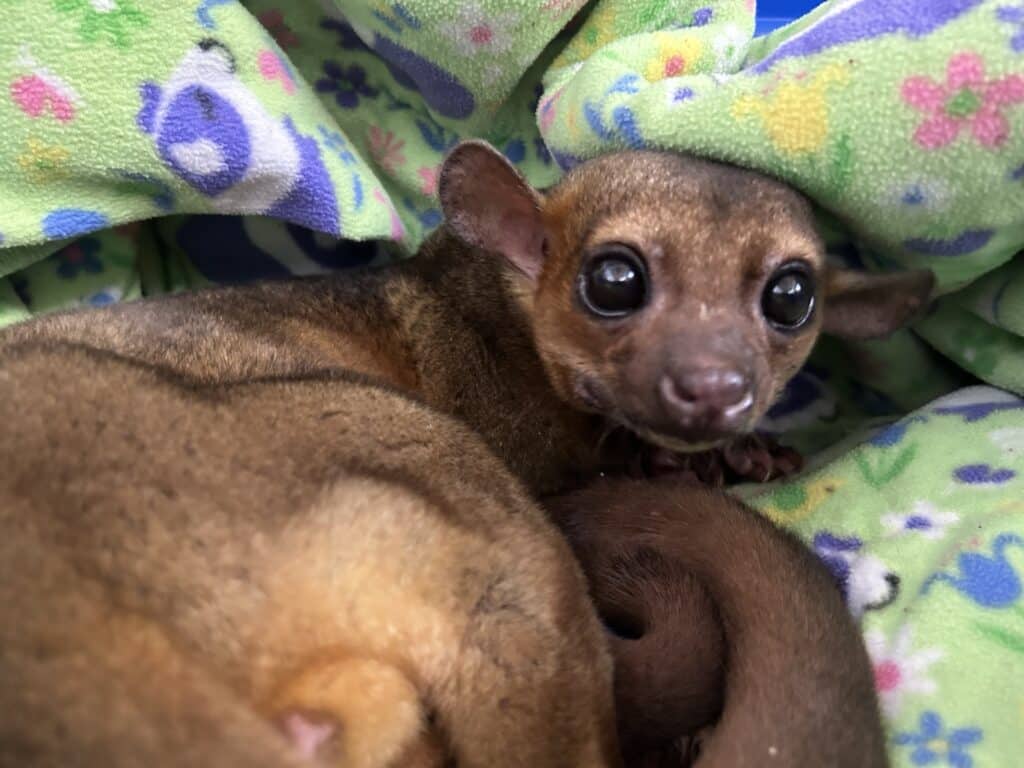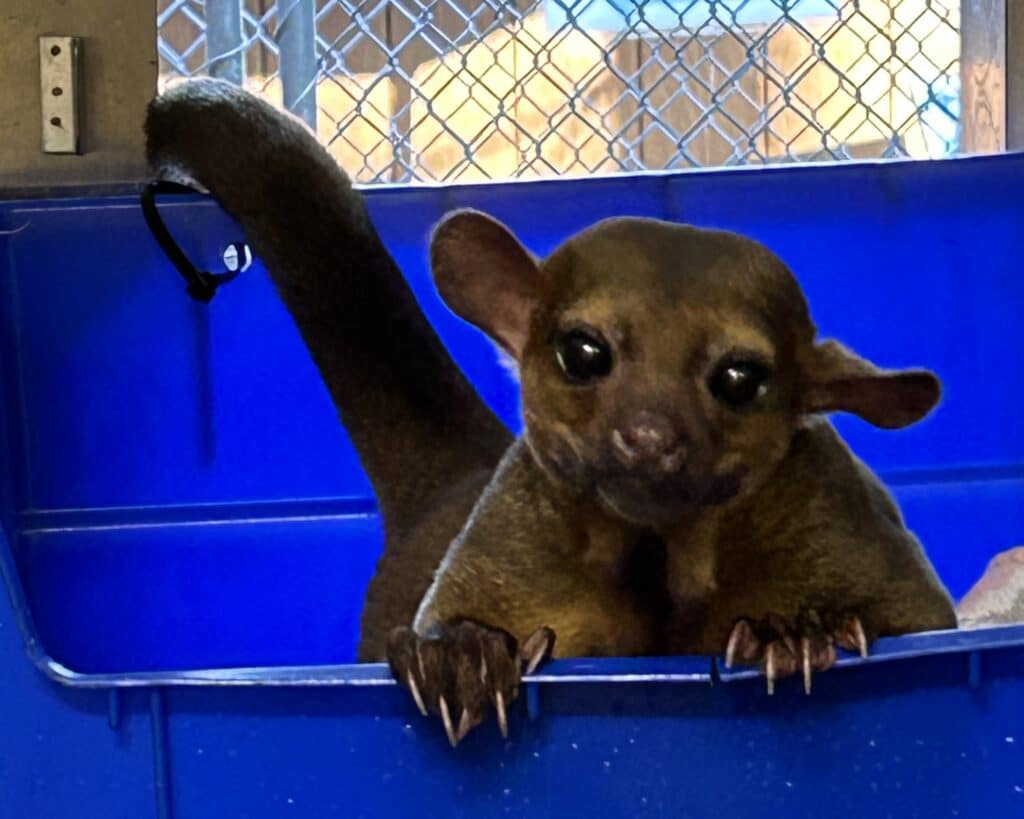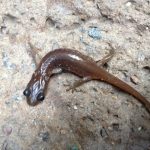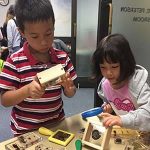Blog
CuriOdyssey Fights Wildlife Trafficking with Jerry the Kinkajou

“He’s a kinkajou and his name is Jerry, that’s all I know.”
When our Director of Wildlife, Nikii Finch-Morales received a call from the Warden at the California Department of Fish and Wildlife asking if we could help care for a kinkajou, she didn’t know much, but she knew we had to think carefully and act fast.
There’s a good reason why California has some of the most restrictive laws and regulations related to the possession of exotic species, such as kinkajous. Most people who unlawfully possess exotic species lack the equipment and experience to properly care for them, resulting in unsanitary and often inhumane living conditions. Exotic species usually require advanced levels of care, special diets, special enclosures, and special veterinary needs. They can also carry diseases not common to other animals, domestic and wild, and can spread those diseases. There is also a risk of the animals escaping in large enough numbers to create a self-sustaining population. When the owner tires of the additional upkeep, they are often released into the wild or our waterways, another unlawful act that can lead to additional suffering for the animal, or harm to our native species who live in those habitats.
Recently, wildlife officers from the California Department of Fish and Wildlife (CDFW), seized an unlawfully possessed kinkajou and turned it over to us at CuriOdyssey for temporary care during the investigation. CuriOdyssey not only has the permit and expertise to care for an animal like Jerry, but our organization has a track record of educating the public about the harm of possessing exotic species and wildlife trafficking in general.
In 2023 we’ve had an influx of calls from different wardens that they’re planning a confiscation and are looking for facilities—an unusually high volume, given the size of our organization. The only information they can give us ahead is that they’re planning a confiscation and what type of animal they suspect it is. Given our focus on California wildlife, combined with the size of our quarantine space, we rarely have the capacity to jump in and help with a confiscated animal (the exception being a pair of ferrets we agreed to take in and ended up keeping back in 2017).
While we knew right away that we weren’t the right long-term fit for Jerry, (CuriOdyssey only exhibits native CA wildlife, and we do not have room in our Ambassador Program for a kinkajou), Nikii collaborated with Kate Sulzner, our Director of Animal Health and Conservation, and our vet tech Kendra Jabin, to create a safe landing space for Jerry while we worked with AZA to find him a permanent placement. Animals that cannot find a safe short-term placement from confiscations like this can sometimes be euthanized, and we were determined to help CDFW avoid that outcome.
Nikii had previously cared for kinkajous at another facility, so she had an idea of Jerry’s possible needs and care requirements, but since we would be taking him in with no sense of his health, ability or disability, or aggression levels, our wildlife team took great care transferring Jerry into our care. Two hours out, we received the call confirming that they had Jerry in custody. Upon arrival they met CDFW in our parking lot, and brought Jerry’s carrier into our quarantine area. All staff were gowned up including leather gloves just in case to keep both Jerry and our staff safe.

We set him up in a small subsection of our quarantine space with a camera to monitor him for the first day or so to maximize his possible comfort. He was very calm, climbed right up and out of his crate, and went right to bed. By nighttime, his nocturnal nature meant he was up and about climbing the walls—literally! As any new pet owner knows, new spaces can be stressful for animals, and Jerry was no exception. We decided after watching him on the video we should try and give him some more space to relieve the stress and opened the outer quarantine area, and he was excited to climb all over every square inch. After a few weeks of proper care, nutrition, and A LOT of enrichment, video footage of his nocturnal activities showed that he became much calmer and settled in.
We also discovered Jerry sucks his paw when he sleeps, usually a sign that he was taken from his mom too soon in order to imprint him on people super early, which means there’s no chance of him getting back to the wild. While we will never be sure about Jerry’s full history, we can guess confidently that he was born in captivity, and raised by people with the intent of making him a pet. We’ve only had him for two months, and he’ll let our medical team examine him literally everywhere, which is extremely unusual for an animal not extremely habituated to human contact.
After a full exam, including x-rays and labs, we have learned he’s very healthy and between six and seven years old—fully adult but not old, as kinkajous can live up to 25 years in captivity. On Nov. 6th we received an update from CDFW that they had new information on the kinkajou that stated Jerry had been harness trained, and was likely used for educational programs before coming into CA—these traits will make him much easier to care for when he reaches his permanent home. We are hoping to place him with another AZA organization, and have been in talks with another facility who is interested, so hopefully that permanent home is not too far away!
Kinkajous are fructivores with the occasional insect in their diet (although Jerry has turned his nose up at insects so far, going straight for the fruit). Kinkajous are a keystone species in the rainforests where they live, and are critical for spreading seeds and repopulating plants in the rainforest. Their incredibly fast metabolism means that the seeds from all the fruit they eat make it all the way through their digestive systems intact. Sometimes they’re called Honey Bears because they’ll raid beehives—their super dense fur protects them from bee stings (his only unprotected parts are his nose and palms) and that high metabolism means they need all the sugary energy they can get!
Kinkajous are procyonids (related to racoons), and are arboreal, almost never going to the ground unless they need to get to a tree they can’t reach—the more deforestation happens, the more they’ll need to go to ground. They’re also the only procyonid with a prehensile tail, which acts like a fifth limb, helping his balance and making him an incredible climber. They’re strictly nocturnal as well, which is why he looks so sleepy in his photos—he’s very much not a morning person. Jerry, being socialized with humans all his life, has no sense of personal space, and is always trying to stick his nose in our keeper’s ears or checking up their sleeves for snacks.
While Kinkajous are not endangered, they are an exotic animal that requires highly specialized care. Despite this, there are unfortunately currently 38 states that allow them as pets. Luckily California is not one of them, and CDFW was able to get him to us and his soon to be selected eventual home, where he’ll receive the care and support he needs for the rest of his life. We’re so proud to be able to support CDFW in their fight against animal trafficking and hope that Jerry’s story spreads the word about why wild and exotic species like Kinkajous, do not make good pets and are illegal to have in CA.
Looking to support our conservation program? Donate to CuriOdyssey today.
Join the CuriOdyssey Community
LOCATION
1651 Coyote Point Drive
San Mateo, CA 94401
Ohlone Land Acknowledgement
650-342-7755
[email protected]
CuriOdyssey is a 501(c)(3) non-profit, Tax ID 94-1262434




